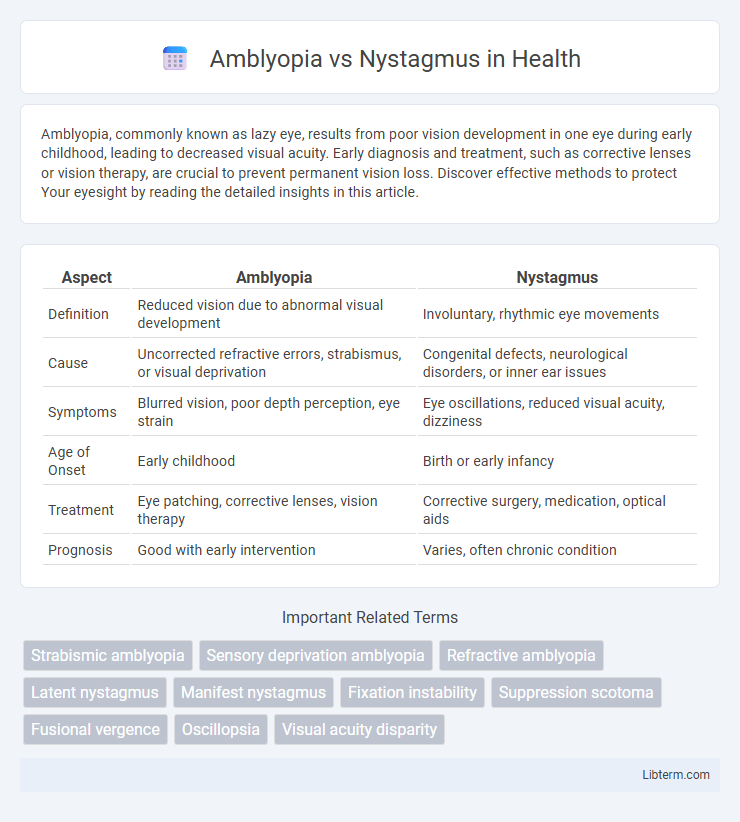Amblyopia, commonly known as lazy eye, results from poor vision development in one eye during early childhood, leading to decreased visual acuity. Early diagnosis and treatment, such as corrective lenses or vision therapy, are crucial to prevent permanent vision loss. Discover effective methods to protect Your eyesight by reading the detailed insights in this article.
Table of Comparison
| Aspect | Amblyopia | Nystagmus |
|---|---|---|
| Definition | Reduced vision due to abnormal visual development | Involuntary, rhythmic eye movements |
| Cause | Uncorrected refractive errors, strabismus, or visual deprivation | Congenital defects, neurological disorders, or inner ear issues |
| Symptoms | Blurred vision, poor depth perception, eye strain | Eye oscillations, reduced visual acuity, dizziness |
| Age of Onset | Early childhood | Birth or early infancy |
| Treatment | Eye patching, corrective lenses, vision therapy | Corrective surgery, medication, optical aids |
| Prognosis | Good with early intervention | Varies, often chronic condition |
Overview of Amblyopia and Nystagmus
Amblyopia, commonly known as lazy eye, is a neurodevelopmental disorder characterized by reduced vision in one or both eyes due to abnormal visual experience during early childhood. Nystagmus is an involuntary, rapid, and repetitive movement of the eyes, which can be congenital or acquired and often impairs visual stability and clarity. Both conditions affect visual function but differ in etiology, with amblyopia arising from disrupted visual input and nystagmus resulting from abnormal eye movement control mechanisms.
Causes of Amblyopia
Amblyopia, commonly known as lazy eye, is primarily caused by factors that disrupt normal visual development such as strabismus (misaligned eyes), significant refractive errors, or deprivation due to cataracts or ptosis during early childhood. In contrast, nystagmus is characterized by involuntary eye movements and is often congenital or linked to neurological or sensory disorders rather than developmental disruption. Understanding the distinct causes of amblyopia is crucial for targeted treatments to prevent permanent visual impairment.
Causes of Nystagmus
Nystagmus primarily arises from congenital factors, neurological disorders, or inner ear problems affecting the vestibular system. Causes include genetic mutations, brain injuries such as stroke or multiple sclerosis, and vestibular nerve damage leading to involuntary eye movements. Unlike amblyopia, which results from abnormal visual development, nystagmus is often linked to disruptions in the ocular motor pathways or sensory input integration.
Key Differences Between Amblyopia and Nystagmus
Amblyopia, commonly known as lazy eye, is characterized by reduced vision in one eye due to abnormal visual development during childhood, whereas nystagmus involves involuntary, repetitive eye movements that can affect vision stability. Amblyopia primarily affects visual acuity without causing eye movement abnormalities, while nystagmus is defined by rhythmic oscillations that impair steady focus and depth perception. Treatment for amblyopia focuses on improving visual input through methods like patching or corrective lenses, while nystagmus management aims to reduce eye movement through medications, surgery, or specialized contact lenses.
Signs and Symptoms Comparison
Amblyopia presents primarily with reduced vision in one eye without an obvious structural defect, often accompanied by poor depth perception and favoring one eye. Nystagmus is characterized by involuntary, rhythmic eye movements that can cause vision to appear shaky or blurry, frequently leading to oscillopsia and difficulty focusing. Both conditions impact visual acuity but differ markedly in their clinical signs, with amblyopia showing static vision impairment and nystagmus displaying dynamic ocular instability.
Diagnosis: How Amblyopia and Nystagmus Are Identified
Amblyopia is diagnosed through comprehensive eye exams assessing visual acuity differences between eyes, often detected using eye charts and focus tests in children. Nystagmus is identified by observing involuntary, rhythmic eye movements via clinical eye exams, sometimes complemented by electronystagmography to measure eye motion. Early diagnosis in both conditions is crucial for effective treatment and vision preservation.
Treatment Options for Amblyopia
Treatment options for amblyopia primarily include patching the dominant eye to strengthen the weaker eye, atropine eye drops to blur vision in the stronger eye, and vision therapy exercises designed to improve eye coordination and focusing skills. Early detection and consistent treatment during childhood yield the best outcomes, while treatments for adults remain more limited and less effective. In contrast, nystagmus treatment focuses on managing symptoms through corrective lenses, medications, or surgery rather than addressing amblyopia's neural suppression mechanisms.
Management and Treatment of Nystagmus
Nystagmus management primarily focuses on minimizing symptoms and improving vision through the use of corrective lenses, medications like gabapentin or memantine, and in some cases, surgical interventions such as tenotomy or extraocular muscle surgery. Optical aids, including prisms and contact lenses, help stabilize gaze and reduce oscillopsia. Vision therapy and specialized low vision aids further support functional vision improvement in nystagmus patients.
Prognosis and Long-term Outcomes
Amblyopia prognosis improves significantly with early detection and consistent visual therapy, often resulting in enhanced visual acuity and binocular vision, though untreated cases may lead to permanent vision loss. Nystagmus prognosis varies based on underlying causes; while some forms stabilize over time, others can lead to chronic visual impairment and difficulties with depth perception and coordination. Long-term outcomes for both conditions depend on timely intervention, with amblyopia showing better recovery potential compared to nystagmus, which frequently requires ongoing management to optimize quality of life.
Preventive Strategies and Early Intervention
Preventive strategies for amblyopia primarily involve early vision screening in children to detect and treat refractive errors, strabismus, or cataracts that hinder normal visual development. Early intervention for nystagmus includes diagnosing underlying conditions and employing therapies such as vision therapy or surgical options to improve eye stability and reduce symptoms. Timely identification and consistent treatment are crucial in minimizing long-term visual impairment in both disorders.
Amblyopia Infographic

 libterm.com
libterm.com